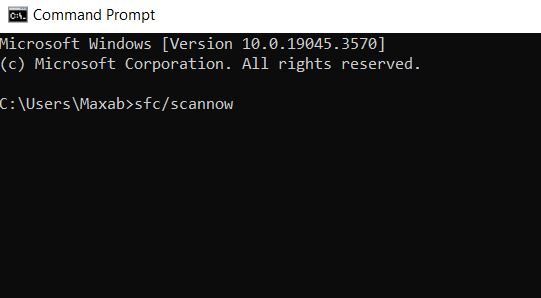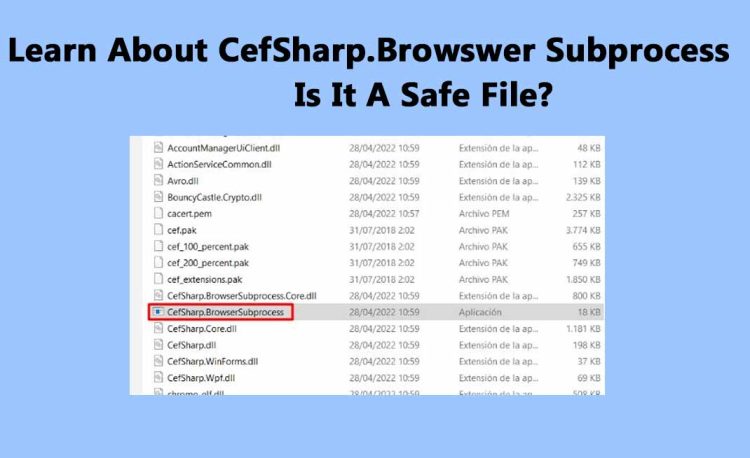CefSharp.BrowserSubprocess.exe is an essential component of the Chromium Embedded Framework (CEF) that empowers developers to embed web browser capabilities into their applications.
Specifically designed for .NET applications, it serves as a bridge between your .NET code and the CEF libraries, enabling web rendering and interaction.
This headless browser sub-process is responsible for rendering web content, executing JavaScript, and ensuring that web-related functionalities function smoothly within your applications.
By running these web processes in a separate sub-process, it maintains the responsiveness of the main application.
In essence, CefSharp.BrowserSubprocess.exe is the engine that drives the display of web content within your .NET applications, enhancing user experiences significantly.

Where is CefSharp.BrowserSubprocess.exe Located?
On Windows:
On Windows-based operating systems, CefSharp.BrowserSubprocess.exe is typically found in the installation directory of the application that uses CefSharp.
This ensures that it’s closely tied to the application’s functionality.
However, it might also be stored in system folders or directories like “C:\Program Files” or “C:\Program Files (x86).”
On Linux and macOS:
On Linux and macOS, the location can vary based on where the CEF library and CefSharp have been installed.
Typically, you’ll find CefSharp.BrowserSubprocess.exe within the application’s directory or in directories like “/usr/lib” on Linux or “/Applications” on macOS.
Is CefSharp.BrowserSubprocess.exe a Virus or Malware?
CefSharp.BrowserSubprocess.exe is not a virus or malware. However, it’s crucial to be aware of potential security threats.
Cybercriminals might exploit CefSharp.BrowserSubprocess.exe to disguise malware, making it essential to differentiate between genuine and malicious versions.
Do I Need to Delete Cefsharp.browsersubprocess.exe?
In most situations, you don’t need to delete cefsharp.browsersubprocess.exe from your computer.
It’s a legitimate part of the CEF framework, and many applications rely on it for proper operation.
However, if you notice anything unusual or suspect that this file might be compromised, it’s wise to investigate further.
Here are some steps you can take to make sure that cefsharp.browsersubprocess.exe is safe:
1. Recognizing CefSharp.BrowserSubprocess.exe
CefSharp.BrowserSubprocess.exe should always be digitally signed by a reputable source. Check the digital signature’s details to verify authenticity.
Additionally, the file location should match its application, and it should not run from unusual or suspicious directories.
2. Identifying Malicious Activity:
Signs of a malicious CefSharp.BrowserSubprocess.exe include high CPU or memory usage, unauthorized network connections, or unexpected error messages.
If you encounter these issues, it’s imperative to investigate further to safeguard your system’s security.
Troubleshooting Common CefSharp.BrowserSubprocess.exe Issues
1. High CPU or Memory Usage:
Excessive resource usage can slow down your system. To mitigate this, ensure your CefSharp and the application using it are up to date.
Sometimes, disabling unnecessary browser tabs or extensions can alleviate resource consumption.
2. Errors and Crashes:
If you encounter error messages related to CefSharp.BrowserSubprocess.exe or if it crashes frequently, updating your CefSharp version is a good first step.
Additionally, examining logs and conducting thorough error analysis can help identify and resolve issues.
How to Manage CefSharp.BrowserSubprocess.exe
1. Updating CefSharp:
Regular updates are essential to benefit from bug fixes, security enhancements, and improved performance.
Always ensure that you’re using the latest version of CefSharp in your applications.
2. Managing Processes:
In applications with multiple instances of CefSharp.BrowserSubprocess.exe, optimizing process management is crucial.
Allocate system resources wisely, and avoid unnecessary browser instances to maintain optimal performance.
How to Remove & Uninstall CefSharp.BrowserSubprocess.exe
CefSharp.BrowserSubprocess.exe is an integral part of applications that use the Chromium Embedded Framework (CEF) for web browser functionality.
Therefore, removing it might not always be straightforward. Nevertheless, if you want to uninstall CefSharp.BrowserSubprocess.exe, you can follow these general steps:
1. Uninstall the Associated Application:
CefSharp.BrowserSubprocess.exe is used by applications that depend on CEF. To get rid of it, you’ll often have to uninstall the application itself.
This might involve going to “Control Panel” on Windows, “Applications” on macOS, or using package managers like APT on Linux.
2. Check for Residual Files:
After uninstalling the application, it’s wise to check for any residual files. Sometimes, uninstallers don’t remove everything.
Look in the application’s installation directory for leftover files related to CefSharp.BrowserSubprocess.exe.
3. Clean the Registry (Windows):
If you’re using Windows, make sure to clean the Windows Registry using tools like CCleaner. Be cautious when editing the registry as it’s a sensitive part of the system.
Remember that uninstalling CefSharp.BrowserSubprocess.exe might affect the functionality of applications that rely on it.
Ensure you’re comfortable with the consequences before proceeding.
How Do You Stop CefSharp.BrowserSubprocess.exe Processes?
CefSharp.BrowserSubprocess.exe runs as a subprocess within applications and typically shouldn’t be manually stopped, as it’s crucial for web functionality within those applications.
However, if you’re facing performance issues or high resource usage due to CefSharp.BrowserSubprocess.exe, you can consider the following steps:
1. Close the Application:
The most straightforward way to stop CefSharp.BrowserSubprocess.exe is to close the application utilizing it.
If it’s a web browser or a specific application, exiting the program will terminate the associated CefSharp.BrowserSubprocess.exe processes.
2. Update the Application:
Ensure that the application using CefSharp is up to date. Developers often release updates that optimize resource usage and fix performance-related issues.
3. Optimize Browser Tabs:
If it’s a web browser utilizing CefSharp.BrowserSubprocess.exe, limit the number of open tabs and extensions.
Having too many tabs or resource-intensive extensions can lead to high resource usage.
4. Check for Malware:
In rare cases, CefSharp.BrowserSubprocess.exe might be compromised by malware. Run a thorough antivirus and anti-malware scan to ensure your system’s security.
Monitoring CefSharp.BrowserSubprocess.exe CPU Usage
High CPU usage by CefSharp.BrowserSubprocess.exe can slow down your system. Here’s how to check if this is happening and what to do:
Task Manager (Windows):
Press Ctrl + Shift + Esc or Ctrl + Alt + Delete and select “Task Manager.” Under the “Processes” tab, locate “CefSharp.BrowserSubprocess.exe.”

The “CPU” column will show the percentage of CPU usage. If it’s consistently high, it might be causing performance issues.
Activity Monitor (macOS):
Open “Activity Monitor” from the “Applications” folder. Under the “CPU” tab, find “CefSharp.BrowserSubprocess.” A high percentage indicates high CPU usage.
System Monitor (Linux):
Use the “System Monitor” application or run a command like htop in the terminal to check CPU usage.
If you observe high CPU usage by CefSharp.BrowserSubprocess.exe, consider closing unnecessary tabs or extensions in the associated application.
Additionally, ensure that both the application and CefSharp are updated to the latest versions.
How to Check if CefSharp.BrowserSubprocess.exe Is Causing High Disk Usage
Excessive disk usage can lead to performance problems. To check if CefSharp.BrowserSubprocess.exe is causing high disk activity:
Task Manager (Windows):
Open “Task Manager” and go to the “Processes” tab. Look for “CefSharp.BrowserSubprocess.exe.”
The “Disk” column will show the data read/written to the disk. If it’s significantly high, it might be causing disk-related issues.
Activity Monitor (macOS):
In “Activity Monitor,” under the “Disk” tab, check for “CefSharp.BrowserSubprocess.” High disk activity indicates an issue.
System Monitor (Linux):
Use the “System Monitor” or tools like iotop in the terminal to check disk activity.
If CefSharp.BrowserSubprocess.exe is causing high disk usage, try closing unnecessary tabs or extensions in the application using it.
Ensure both the application and CefSharp are updated, as updates often include optimizations to reduce disk usage.
Remember that high resource usage can sometimes be a result of web content, so consider your browsing habits and the websites you visit as well.
By following these steps, you can effectively manage CefSharp.BrowserSubprocess.exe, ensuring it doesn’t cause undue resource consumption or performance issues on your system.
CefSharp.BrowserSubprocess.exe Error Messages
CefSharp.BrowserSubprocess.exe, being a crucial part of applications that use the Chromium Embedded Framework (CEF), may sometimes generate error messages.
These error messages are typically indicative of issues within the CEF-based application and can vary in their nature and severity.
Understanding these errors is essential for effective troubleshooting and problem resolution.
Here are some common CefSharp.BrowserSubprocess.exe error messages and what they signify:
CefSharp.BrowserSubprocess.exe Application Error:
This error is a generic message that suggests an issue within the CefSharp.BrowserSubprocess.exe itself or in how it interacts with the parent application.
It could be caused by corrupt installation files, conflicts with other applications, or missing dependencies.
CefSharp.BrowserSubprocess.exe Has Stopped Working:
This error typically indicates a crash of the CefSharp.BrowserSubprocess.exe.
It might be caused by issues with memory management, incompatible browser extensions, or damaged program files.
CefSharp.BrowserSubprocess.exe – Entry Point Not Found:
This error implies that the CefSharp.BrowserSubprocess.exe is unable to locate a specific function or method within its code.
This could be due to issues with the CEF version, conflicts with system libraries, or corruption in the application files.
CefSharp.BrowserSubprocess.exe – Application Error (0xc000008):

This is a common Windows application error code. It may indicate issues with the CefSharp.BrowserSubprocess.exe’s compatibility with your system or conflicts with other software.
CefSharp.BrowserSubprocess.exe – Bad Image:
This error message occurs when the executable file is corrupted, potentially due to malware, or if there are issues with system files.
Dealing with these error messages involves various troubleshooting steps. Here’s a general approach to resolving them:
1. Check for Updates:
Ensure that both the CefSharp-based application and your operating system are up to date. Many errors are fixed through software updates.

2. Reinstall or Repair:
Try reinstalling the CefSharp-based application to replace potentially corrupted files. Some applications also have built-in repair options.
3. Check for Malware:
Run a thorough antivirus and anti-malware scan to detect any threats that may be causing errors.
4. Examine System Files:
Use the System File Checker tool (sfc /scannow) to scan and repair corrupted or missing system files.

5. Resolve Dependencies:
If the error points to missing DLL files, install or repair the associated dependencies.
6. Browser Extensions:
Disable or remove browser extensions that might be conflicting with CefSharp.BrowserSubprocess.exe.
7. Compatibility Mode:
Try running the application in compatibility mode, especially if you’re facing compatibility-related errors.
By understanding the nature of these error messages and following the appropriate troubleshooting steps, you can often resolve issues related to CefSharp.BrowserSubprocess.exe and the applications it supports.
Conclusion
It’s important to remember that CefSharp.BrowserSubprocess.exe is not inherently malicious, but like any other executable, it can be susceptible to issues arising from software conflicts, system changes, or malware.
By following the guidelines and solutions outlined in this comprehensive guide, you can navigate the intricacies of CefSharp.BrowserSubprocess.exe and maintain a smoother and more secure digital experience.

It’s me Mosaab, the founder and leading author of MalwareYeti.com. Over the years, I have gained a lot of experience when it comes down to building or fixing computers. Throughout my journey, I’ve built gaming PCs, fixed irritating Windows errors, and removed sticky malware/viruses that have affected machines. You can learn more about me on our About us page.

